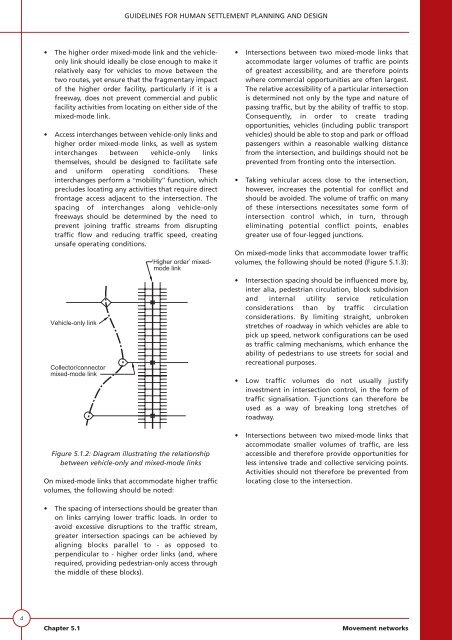VOLUME 1 HUMAN SETTLEMENT PLANNING AND ... - CSIR
VOLUME 1 HUMAN SETTLEMENT PLANNING AND ... - CSIR
VOLUME 1 HUMAN SETTLEMENT PLANNING AND ... - CSIR
- No tags were found...
You also want an ePaper? Increase the reach of your titles
YUMPU automatically turns print PDFs into web optimized ePapers that Google loves.
GUIDELINES FOR <strong>HUMAN</strong> <strong>SETTLEMENT</strong> <strong>PLANNING</strong> <strong>AND</strong> DESIGN• The higher order mixed-mode link and the vehicleonlylink should ideally be close enough to make itrelatively easy for vehicles to move between thetwo routes, yet ensure that the fragmentary impactof the higher order facility, particularly if it is afreeway, does not prevent commercial and publicfacility activities from locating on either side of themixed-mode link.• Access interchanges between vehicle-only links andhigher order mixed-mode links, as well as systeminterchanges between vehicle-only linksthemselves, should be designed to facilitate safeand uniform operating conditions. Theseinterchanges perform a “mobility” function, whichprecludes locating any activities that require directfrontage access adjacent to the intersection. Thespacing of interchanges along vehicle-onlyfreeways should be determined by the need toprevent joining traffic streams from disruptingtraffic flow and reducing traffic speed, creatingunsafe operating conditions.Vehicle-only linkCollector/connectormixed-mode link‘Higher order’ mixedmodelinkFigure 5.1.2: Diagram illustrating the relationshipbetween vehicle-only and mixed-mode linksOn mixed-mode links that accommodate higher trafficvolumes, the following should be noted:• Intersections between two mixed-mode links thataccommodate larger volumes of traffic are pointsof greatest accessibility, and are therefore pointswhere commercial opportunities are often largest.The relative accessibility of a particular intersectionis determined not only by the type and nature ofpassing traffic, but by the ability of traffic to stop.Consequently, in order to create tradingopportunities, vehicles (including public transportvehicles) should be able to stop and park or offloadpassengers within a reasonable walking distancefrom the intersection, and buildings should not beprevented from fronting onto the intersection.• Taking vehicular access close to the intersection,however, increases the potential for conflict andshould be avoided. The volume of traffic on manyof these intersections necessitates some form ofintersection control which, in turn, througheliminating potential conflict points, enablesgreater use of four-legged junctions.On mixed-mode links that accommodate lower trafficvolumes, the following should be noted (Figure 5.1.3):• Intersection spacing should be influenced more by,inter alia, pedestrian circulation, block subdivisionand internal utility service reticulationconsiderations than by traffic circulationconsiderations. By limiting straight, unbrokenstretches of roadway in which vehicles are able topick up speed, network configurations can be usedas traffic calming mechanisms, which enhance theability of pedestrians to use streets for social andrecreational purposes.• Low traffic volumes do not usually justifyinvestment in intersection control, in the form oftraffic signalisation. T-junctions can therefore beused as a way of breaking long stretches ofroadway.• Intersections between two mixed-mode links thataccommodate smaller volumes of traffic, are lessaccessible and therefore provide opportunities forless intensive trade and collective servicing points.Activities should not therefore be prevented fromlocating close to the intersection.• The spacing of intersections should be greater thanon links carrying lower traffic loads. In order toavoid excessive disruptions to the traffic stream,greater intersection spacings can be achieved byaligning blocks parallel to - as opposed toperpendicular to - higher order links (and, whererequired, providing pedestrian-only access throughthe middle of these blocks).4Chapter 5.1Movement networks
















